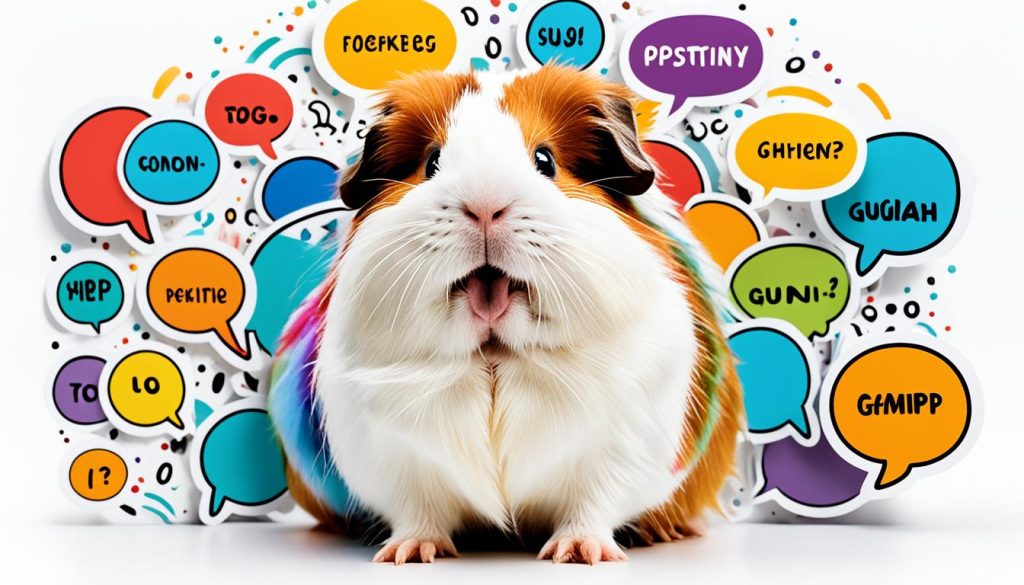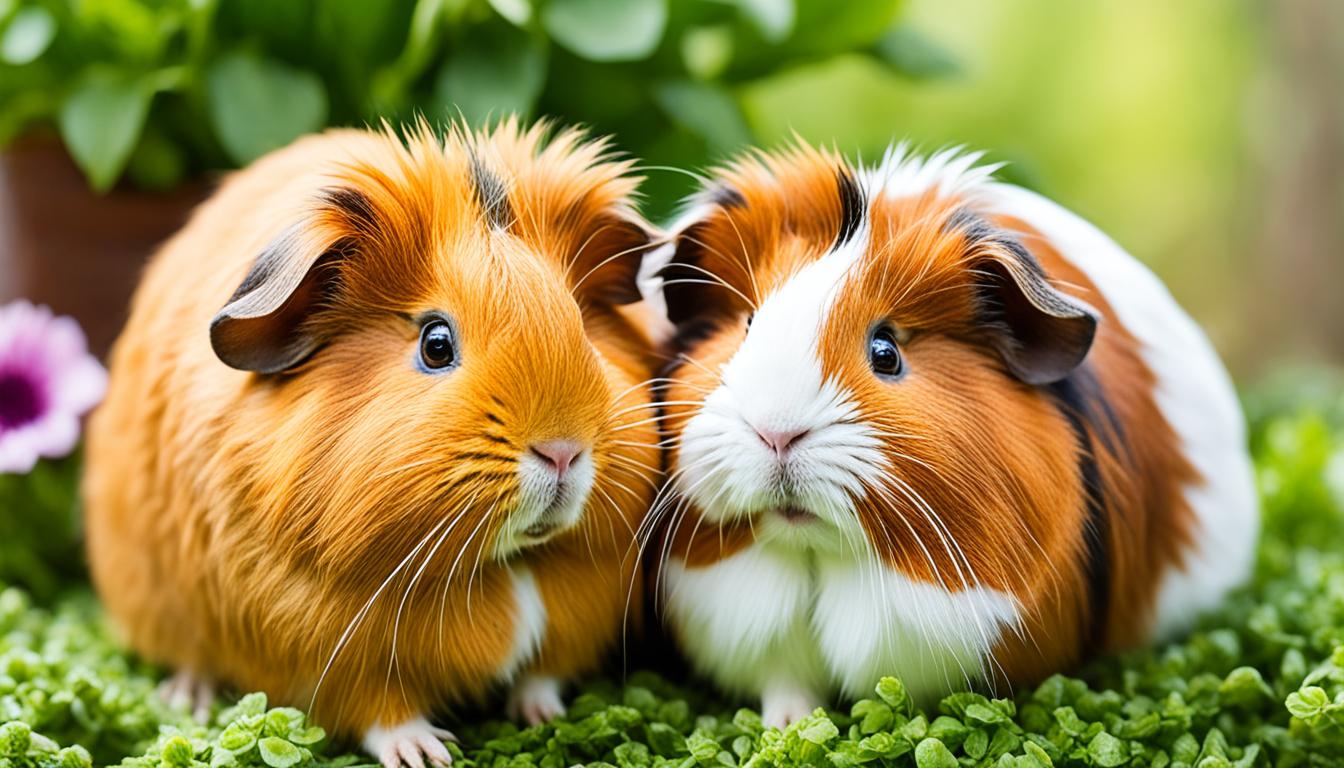Understanding Abyssinian Guinea Pig vocalizations strengthens the bond between pet and owner. Their chirps, squeaks, and purrs are not just noises but meaningful attempts at communication.
By tuning into these vocal and body language cues, you can decipher your pet’s feelings and needs. Whether it’s an excited wheek for food or a gentle nudge for attention, each signal deepens your connection.
This guide to Abyssinian Guinea Pig communication is your key to unlocking a more profound understanding of your furry friend’s attempts to interact with you.
Key Takeaways
- Learn the different vocalizations that Abyssinian guinea pigs use to express their emotions and desires.
- Identify what certain body language gestures mean, enriching the way you interact with your pet.
- Gain insights on how to respond to your guinea pig’s communication, fostering a bond that is based on mutual understanding.
- Become familiar with the social needs of your guinea pig, encouraging a healthy and happy lifestyle for them.
- Utilize this Abyssinian guinea pig communication guide to ensure you’re meeting both the emotional and physical needs of your pet.
Deciphering the Language of Abyssinian Guinea Pigs
Unlocking the secrets behind interpreting guinea pig communication opens the door to a fascinating world where sounds and actions merge to form a language of their own.
As an Abyssinian guinea pig owner, recognizing the types of guinea pig sounds and their accompanying behaviors is essential for meeting the natural needs of these expressive pets.
The Significance of Vocalizations and Body Language
When you delve into guinea pig communication, you’ll quickly observe that vocalizations and body language are deeply interconnected. Each vocal cue from your guinea pig potentially signifies a specific emotional or physical requirement, mirroring the intricacies of human non-verbal cues.
Notably, Abyssinian guinea pigs enrich their messages with not just sounds, but also with a dance or flick of their tiny bodies.
Interpreting Common Sounds and Behaviors
Acquiring the skill of deciphering guinea pig sounds and behaviors can greatly enhance your caregiving efforts. For example, the unmistakable ‘wheek’ might signal it’s feeding time, while ‘purring’ could be synonymous with tranquility.
Conversely, a ‘shriek’ might indicate a need for immediate attention, hinting at potential distress or discomfort. Identifying these vocalizations stems from patient observation and a desire to understand your pet’s unique language.
The following table displays some common vocalizations and their most widely accepted meanings:
| Sound | Description | Common Interpretation |
|---|---|---|
| Wheeking | High-pitched and sustained | Hunger or anticipation for treats |
| Purring | Deep and rhythmic | Contentment, sometimes accompanied by a relaxed posture |
| Shrieking | Sharp and urgent | Pain, fear, or severe discomfort |
| Bubbling | Soft and infrequent | Profound happiness, often accompanied by ‘pancaking’ |
| Chattering | Rapid clicking sounds | Anxiety, irritation, or a warning signal to keep distance |
The Emotional Palette Expressed Through Sounds
Viewing guinea pig emotional communication as a rich tapestry of sounds helps you appreciate not just the physical vitality, but the emotional wellness of your Abyssinian guinea pig. Like a vibrant canvas, each sound and gesture paints a picture of their inner emotional state.
As you spend more time with your pet, you’ll start interpreting guinea pig communication with greater ease, responding to the cheerful chuttings of contentment and discerning the need for comfort when distressed whines emerge.
Forging this deep, empathetic bond with your Abyssinian guinea pig not only enhances their quality of life but deepens your shared connection.
Remember, patience is key – it’s the quiet, observant moments spent watching and listening to your guinea pig that will reveal the nuances of their communication.
In the end, fostering this understanding transforms the care for your companion into a fulfilling journey rather than a mere routine.
Communication and Vocalizations in Abyssinian Guinea Pigs
If you’re keen on understanding Abyssinian guinea pig behavior, tuning in to their unique guinea pig vocalizations serves as the key to their world. These small pets communicate a wealth of information through sounds and movements that, once decoded, can paint a vivid picture of their emotional and physical state.
The way they interact with you and their environment is both fascinating and insightful, offering a glimpse into the needs and moods of your furry friend.
For instance, when your Abyssinian guinea pig emits a series of loud squeaks, it’s not just seeking attention—it may be telling you it’s time for a meal or that its water bottle is empty.
Meanwhile, the endearing action of headbutting its food bowl is more than just playful behavior; it’s a clear signal of hunger. These may seem like simple behaviors, but they’re substantial indicators of your pet’s wellbeing and happiness.
- Wheeking: A high-pitched sound that usually means they’re excited, often associated with feeding time.
- Purring: Similar to cats, this sound can denote contentment when your pet is being petted or is relaxing.
- Chutting: This may be heard when they as are exploring or during peaceful interactions with other guinea pigs.
- Headbutting: When they playfully nudge their food bowl or your hand, they might be indicating they’re hungry or asking for more petting.
Learning to recognize and respond to these vocal cues not only ensures that you’re meeting their basic needs but also deepens the bond you share.
As you become more adept at interpreting these communications, you’ll find that your relationship with your Abyssinian guinea pig grows stronger and more rewarding.

Let’s delve deeper into the sonic world of these charming creatures. The following table provides a snapshot of the various sounds and their likely meanings, helping you take the first steps towards fluent guinea pig communication:
| Vocalization | Behavior | Meaning |
|---|---|---|
| Loud Squeaks | Seeking Attention | Food or water needed, or desire for interaction |
| Headbutting | Playful Interaction | Indicates hunger or want for play and affection |
| Chattering | Teeth Display | Discomfort or warning to back off |
| Shrieking | High Alert | Sign of pain or extreme distress |
By investing time in guinea pig communication, you encourage a space where your Abyssinian guinea pig feels understood and cared for. So the next time you hear a wheek, purr, or chirp, remember—it’s not just noise, it’s a conversation.
Building a Strong Bond Through Understanding
Embarking on the journey of pet stewardship with an Abyssinian guinea pig brings the delightful opportunity to craft a relationship built on understanding and empathy.
By interpreting guinea pig communication thoroughly, you unveil a world where each vocalization and body gesture holds significant meaning. The grunts, squeaks, and movements are more than just charming quirks; they are sincere expressions of your pet’s needs and feelings.
Embracing the role of a keen observer allows you to decipher these vocal cues in Abyssinian guinea pigs, paving the way to a deep and enduring bond grounded in mutual trust and respect.
How Guinea Pig Sounds Reflect Their Needs
Your journey in understanding Abyssinian guinea pig behavior involves tuning into the chorus of sounds they make throughout the day. From the raspy squeaks hinting at a parched throat to the metallic clank against the water bottle requesting a refill, their vocalizations are direct lines to their needs.
By recognizing and responding to these cues promptly, you solidify a bond that is resilient and filled with trust. As you grow more attuned to their communicative needs, these beloved companions will rely on you as much as you cherish them.
Caring for Your Guinea Pig’s Emotional Well-being
As crucial as it is to cater to their physical needs, caring for Abyssinian guinea pigs also entails nurturing their emotional welfare.
Your pet’s emotional communication can be discerned through their guinea pig body language; take for instance the sprawled-out relaxation indicating contentment, or the peacefulness of closed eyes during sleep, signifying utter trust.
Respond to such signals with a gentle, reassuring presence, steering clear from discomforting actions, to reinforce a positive environment.
In doing so, you will witness the beautiful transformation of your guinea pig from a mere animal in your care to a cherished member of your family fold.
Real-Life Case Studies: Guinness Bean’s Story
The tale of Guinness Bean echoes the profound impact attentive understanding can have on a guinea pig’s quality of life. Guinness didn’t just respond to his caregiver with traditional “Guinea Kisses”; he sought comfort by snuggling close to the heart of the one he trusted most.
Such stories exemplify how deciphering guinea pig sounds and respect for their individuality breed fondness and security.
By embracing a dedicated approach to Abyssinian guinea pig communication guide principles, you will not just accommodate the fundamental requirements of your companion, but also foster a unique and loving relationship that enriches both your lives.

